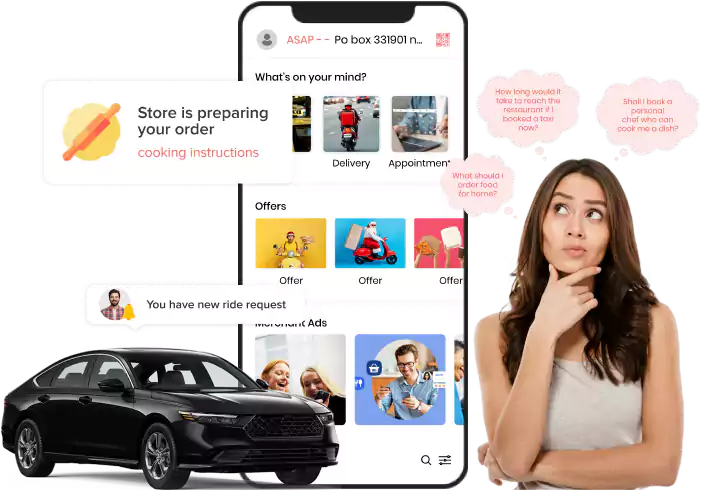Complete List of ESuper Merchant Panel Features
Automating all the manual tasks of managing users and order requests for the merchants.

Merchant Panel
All features combined to offer a seamless experience within the panel.
Social Sign Up
Merchants can use their social media account credentials to register in the app or panel, like Facebook, Twitter, or even its email address.
Reset Forgot Password
In case the password is lost, it could be recovered using the registered email address or a phone number.
Add Referral Code
Merchants can add a referral code while registering, and if they have any accounts already registered, the code can be shared for benefits.
Login with Email or Phone Number
Merchants can log in to the platform directly using the phone number and email address, adding the password.
Login as Merchant and Sub Merchant
There are two types of store accounts – one is a merchant, and another is a sub merchant, which they can choose while logging in.
Merchant’s Verification
Merchants can share the necessary documents in the app or panel to be verified by the admin.
Bank Details
Merchants can add their bank details. With that, they can also choose to add multiple accounts and choose any of them for payments.
Add Cards for E-wallet
Merchants can add multiple cards to link it to the wallet, which they can choose to pay with the wallet.
Request Wallet
Merchants can add their bank account details. They can also choose to add multiple accounts and choose any of them for payments.
Allow Pick Up Delivery
Delivery merchants can allow customers to pick up delivery options. Customers can order online and ask for a pickup service.
Price Ratings
Merchants can keep the price ratings (maximum digits) for the prices of the items or services for the customer’s preferences.
Set Tax
Merchants can choose the tax system for their items or services, whether tax applied inclusive or exclusive to the item.
Free delivery Settings
Merchants can allow free delivery with a minimum ordering amount and distance from the customers.
Order Cancellation
Merchants can decide to set the cancellation charges, applying them at various stages of the delivery process.
Language
Merchants can set multiple languages to allow users to use the app conveniently without any language barrier.
Tags
Merchants can set the tags based on the items they sell or services they offer, allowing customers to reduce browser friction.
Table Booking Settings
Restaurants can allow customers to book a table online, can order online, and pay with the desired method. They can also set booking fees.
Table Cancellations Settings
Restaurants can set cancellation fees for table bookings depending on the status, time, and order.
Set and Update Menu
Merchants can set and update the menu, which includes subcategories, categories, items, and modifiers. It also includes price, tax, description, etc.
Associate Modifier
Merchants can associate modifier groups for different items and set charges based on the size and type of modifiers.
Add Sub Merchants
Merchants can create accounts for sub-merchants to perform specified tasks with assigned screens.
Add Vehicles
Merchants can add vehicles for the partners, for delivery services, add documents and also verify them, and approve them.
Add Partners
Merchants can add their own partners for the delivery of services, adding all the required details and assigning them those account details.
Set Fees
When merchants add their own partners, they can also set fees with the necessary details like base price distance, base prices, etc.
Set Offers
Merchants can create promo codes for the customers and manage their validity and other conditions like time, category, and recursion.
Accept or Reject Requests
Merchants can accept or reject orders from customers depending on the availability of items or services they offer.
Dispatch Orders
Orders will be dispatched by the merchants assigning partners manually by selecting the available partners or by auto-assigning.
Order History
Merchants get the history of all the orders with a separate sheet of weeks, months, and overall earnings for easier analysis.
Create Orders
Merchants can create orders for the customers, select the items and customer details, and book a pickup order.
Reviews
Reviews and ratings given to the orders and services by customers could be analyzed by the merchants to take action for improvements.
Print Invoices
Merchants can print invoices for the completed orders directly by linking the app to the printer via a virtual network called Bluetooth.
Merchant Timings
Merchants can set the timings of their services available during the day and also in the week, which will also be updated anytime they want.
Delivery Timings
Merchants can set the service time in a day and in the whole week to refer it to the customers, which they can also update anytime required.
Earning Sheets
Merchants can analyze orders with the earnings with weekly, monthly or overall data that also includes orders and users’ details.
Schedule Time
Merchants can set details for the customers to schedule orders, which includes the details of the time before which they order, after how much time it lasts, etc.
Delivery Radius
Merchants can set the delivery radius from the merchants where the services are offered and accordingly can set the prices.
Chat with User
Merchants can chat with the customers for any inquiries about the order, items, or payments from the panel or app.
General Settings
Merchants can manage general settings like business status, visibility, and also if the merchant will be visible or not.
Import/Export Sheet
Menu, order list, earnings, and all such lists are imported to the sheet or even exported from the sheet for offline use.
Want to build a high-tech product? Check what we can do for you.
Book a Free Call
